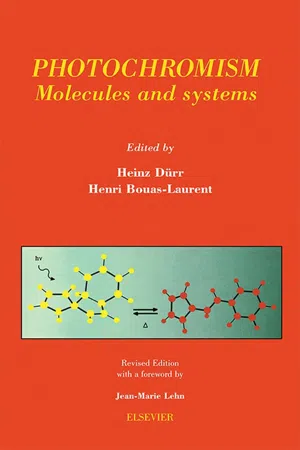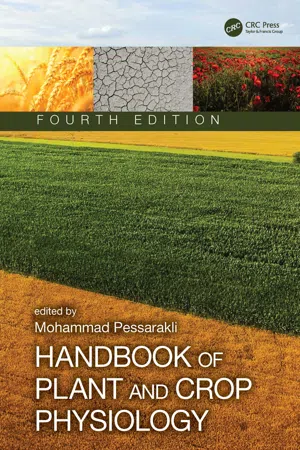Biological Sciences
Phytochromes
Phytochromes are photoreceptors found in plants that are sensitive to red and far-red light. They play a crucial role in regulating various plant processes, including seed germination, seedling development, and flowering. Phytochromes exist in two interconvertible forms, Pr (red light-absorbing) and Pfr (far-red light-absorbing), and their ratio in the plant determines the plant's response to light.
Written by Perlego with AI-assistance
Related key terms
Related key terms
1 of 4
Related key terms
1 of 3
3 Key excerpts on "Phytochromes"
- eBook - ePub
- Heinz Dürr, Henri Bouas-Laurent(Authors)
- 2003(Publication Date)
- Elsevier Science(Publisher)
Chapter 19Phytochrome
S.E. Braslavsky1 INTRODUCTION
Biological photoreceptors have been classified as either light transducers (photosensors or photoperceptors), sensing the quality and quantity of radiation, or as energy converters. Among the first there are (a) different molecular species triggering photomovement at various levels, e. g., movement of motile organisms, intracellular movement, and movement of plant organs in higher plants (ref. 1 ), (b) phytochrome, various blue light/UV-A (320–400 nm) and UV-B (280–320 nm) photoreceptors (ref. 2 ), all of which control to different degrees plant growth and development, and (c) the visual pigments, in particular rhodopsin in vertebrates and various types of pigments in invertebrates (ref. 3 ). Among the energy converters we find bacteriorhodopsin and the protein complexes of the chlorophylls and of bacteriochlorophyll. In addition, the antenna pigments (accesory pigments), like e. g., phycocyanin, phycoerythrin, allophycocyanin, serve to transfer the energy of the absorbed light to the reaction center in algae.Most biological photoreceptor systems are photochromic, i. e., after performing the photochemically triggered reaction, the system is somehow restored to its initial state and is ready to absorb another quantum of radiation in order to photoinitiate again the specific function. Few of these pigments remain photochromic when isolated from the living complex system of which they are part. This is the case for phytochrome. I will concentrate the discussion on this pigment. It has two stable forms that are transformed into each other by light of appropriate wavelength and it does not need an additional partner in order to complete the photochromic cycle.Some years ago Max Delbrück proposed a general concept marking the difference between the light-transducer and the energy-converter photoreceptors. In the former, after the absorption of radiation a flexible chromophore would lead to protein conformational changes inducing this way the transmission of a signal. Alternatively, a rigidly attached chromophore would only lead to charge separation in the energy converters or to energy transfer in the accessory antenna pigments (ref. 4 - eBook - ePub
- Andrew Lack, David Evans(Authors)
- 2021(Publication Date)
- Taylor & Francis(Publisher)
Section I - Sensing and responding to the environmentI1 PHOTOPERIODISM, PHOTOMORPHOGENESIS AND CIRCADIAN RHYTHMSKey Notes
Photoperiodism
Photoperiodism is the response of a plant to length of day. It governs processes such as dormancy and flowering. Species may be either long-day, short-day or day-neutral in their response to day length.Photomorphogenesis
Photomorphogenesis is the direct influence of light on growth and development. It involves responses to certain wavelengths of light perceived by photoreceptor pigments.Phytochrome
Phytochrome is a photoreceptor protein. It is synthesized as Pr that absorbs red light (666 nm) and is converted to Pfr which absorbs far-red light (720 nm), and initiates cell signaling events. Many phytochrome responses initiated by red light are reversed by far-red light. Five phytochrome genes PHYA-PHYE have been identified. PHYA is expressed at high levels in etiolated tissue. In red light its expression is switched off and the protein is rapidly degraded. PHYB-E are constantly expressed at low levels in tissue and are involved in other phytochrome responses. Phytochrome responses include: etiolation /deetiolation, circadian rhythms like leaf and petal movement and seed germination. Phytochrome regulates processes which involve changes in cell turgor (like leaf movements) by altering proton and potassium transport at the cell membrane. Longer-term phytochrome responses involve phytochrome-activated genes.Blue light receptors
A variety of processes including stomatal aperture, chloroplast movement and phototropism are regulated by blue light. Cryptochromes and phototropins are proteins associated with flavins and respond to blue light.Circadian rhythms
Processes with a 24-h cycle, including gene expression, stomatal aperture and growth and leaf and petal movements. An internal oscillator (clock) is generated by the expression of a number of genes, including CCA1, LHY and TOC1 - eBook - ePub
- Mohammad Pessarakli, Mohammad Pessarakli, Mohammad Pessarakli(Authors)
- 2021(Publication Date)
- CRC Press(Publisher)
Figure 6.1 ).Figure 6.1 The schematic model of the effect of light on the flowering of the Arabidopsis plant.FR: far-red light; R: red light; B: blue light.6.3.3 How Does Phytochrome Detect Light?In the discussion of photomorphogenesis, it is also important to focus on signal reception and plant response. Although the findings of this route are not complete, the components of this signal transmission can be examined to some extent. Findings on the transmission of phytochrome signals are much higher than that in cryptocurrencies.The first step in getting light through phytochrome is to absorb a photon by a chromophore; a chromophore is a tetrapyrrole linear molecule that attaches to the phytochrome apoprotein by covalent bonding, and when it receives light, a reversible change occurs to match this state. In PR mode, any link linked to the pyrolysis group is placed in cis mode. When converted to PFR, one of the bonds, like part of the chromophore, is converted to trans mode. It is not clear exactly how this change triggers other changes, but it has been reported that it has changed the range of absorption and other properties of proteins (Opik and Rolfe, 2005 ). Both phytochrome A and B react with other proteins, and both have kinase activity and can phosphorylate themselves and other proteins. A number of proteins, such as PIF3, have been identified that react with phytochrome. The coding genes for these proteins have been found in mutant plants that have shown incomplete responses to red and far-red light. This protein is an important part of the phytochrome signal transmission chain. Motogenetic studies have found plants with damage in the signal transmission chain, and many proteins are predicted to play an important role in signal transmission. In some cases, mutations affect the responses of Phytochromes A or only B, although some mutants affect the responses of both Phytochromes. In addition, some studies have shown that small molecules and proteins such as Ca2+ , circular AMP, and Calmodulin are involved in the early processes of signaling (Anil and Kolluri Rao, 2001 ; Desnos et al., 2020 ). Although the main role of these compounds has not yet been determined, they are important in very rapid responses to activate Phytochromes. Phytochromes A and B are transferred to the nucleus during light absorption. Many changes in plant growth, such as flowering that occur during morphogenesis, result from changes in gene expression (Opik and Rolfe, 2005 ). Although this discussion emphasizes on the reception of light by light receptors and the signal that affects gene expression and causes plant growth and organ formation, hormones such as auxin, gibberellin, cytokinin, and brassinosteroid are still involved in these responses that affect various plant growth processes phenomena (Opik and Rolfe, 2005 ; Liu et al., 2011 ). Recent studies have shown the interaction between cryptochromes with AUX/IAA proteins, BRI1-EMS-SUPPRESSOR 1 (BES1) and BRASSINAZOLE-RESISTANT 1 (BZR1) brassinosteroid-signaling proteins (Wang and Lin, 2020
Index pages curate the most relevant extracts from our library of academic textbooks. They’ve been created using an in-house natural language model (NLM), each adding context and meaning to key research topics.
Explore more topic indexes
Explore more topic indexes
1 of 6
Explore more topic indexes
1 of 4


